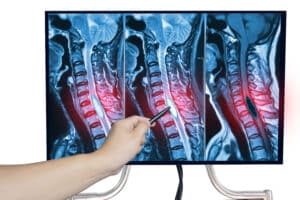
When an accident or other injury severs the spinal cord, it causes a complete spinal cord injury. This cuts off all communication between the brain and the body below the injury. All sensory, motor, and autonomic function below the point of injury stops.
The victim suffers paralysis below the point of injury, so the level of the damage to the spinal cord plays a key role in the extent of their impairment. If the spinal cord is severed in the mid or lower back, the person is likely paraplegic. An injury higher in the back or the neck could cause paralysis in the arms or even difficulty breathing without assistance.
Most Neck and Back Injuries Do Not Sever the Spinal Cord
Most spinal cord injuries do not sever the spinal cord. Most are incomplete injuries that still allow some communication between the brain and the lower body, even if it is minimal. Complete spinal cord injuries do not necessarily sever the spinal cord, either. They can occur because of bruising or damage from swelling and inflammation.
Recovery Following a Severed Spinal Cord
Following a complete tear of the spinal cord, there is little chance of recovery of any sensory or motor function below the level of the injury. However, your doctor will likely recommend you go to inpatient rehabilitation followed by outpatient therapy. This may include physical therapy and occupational therapy.
You will need to rebuild your strength and regain skills in physical therapy, as well as learn how to live with your new impairments in occupational therapy. You may also attend psychological counseling.
Outcomes following a complete spinal cord tear include:
Quadriplegia
When the spinal cord tears in the neck or upper back, the result may be quadriplegia. You may have limited use of your arms and hands or no use of them at all. Some people with a high neck break cannot talk, and many whose injury is above their shoulders require assistance breathing.
People with quadriplegia require help with everyday tasks and may be unable to live independently. Those who require a ventilator may need around-the-clock care for the rest of their life.
Paraplegia
Complete spinal cord injuries that occur below the chest level can lead to paralysis in the trunk and/or lower body. A manual or electric wheelchair makes mobility possible, and the person may be able to live on their own with a high quality of life. This person may lack control of their bladder and bowels. Driving may be possible with hand controls.
Pursuing Compensation for a Complete Spinal Cord Injury
If you or a loved one suffered a completely severed spinal cord, it might be possible to recover compensation for expenses and losses. Recoverable damages may include medical bills, mobility equipment, lost wages and diminished earning capacity, and pain and suffering.
The team from Newsome | Melton can review your case for free and take legal action on your behalf. We can identify the liable party – e.g., the at-fault driver or perpetrator of the crime — and pursue a case to hold them accountable.
Call us at (800) 917-5888 to get started today.
